Effect of Oxygen and Hydrogen Peroxide on the Photocatalytic Degradation of Monochlorobenzene in TiO2 Aqueous Suspension
Abstract
The influences of oxygen and hydrogen peroxide (H2O2) on the degradation and mineralization of monochlorobenzene (MCB) during UV/TiO2 process were investigated. Experimental results indicated that oxygen was a determining parameter for promoting the photocatalytic degradation. The presence of oxygen reduced the illumination time needed for the complete decay of MCB from 240 to 120 min. The photocatalytic degradation of MCB in UV/TiO2/O2 photocatalysis followed a simplified two-step consecutive kinetics. The rate constants of degradation (k1) and mineralization (k2) were increased from 0.016 to 0.046 min−1 and from 0.001 to 0.006 min−1, respectively, as the initial concentration of dissolved oxygen (DO) was increased from 1.6 to 28.3 mg L−1. Owing to the fact that H2O2 acted as an electron and hydroxyl radicals (·OH) scavenger, the addition of H2O2 should in a proper dosage range to enhance the degradation and mineralization of MCB. The optimal H2O2 dosage for MCB degradation was 22.5 mg L−1, whereas the most efficient H2O2 dosage for MCB mineralization was 45.0 mg L−1. In order to minimize the adverse effects of higher H2O2 dosage, including the capture of ·OH radicals and competitive adsorption, and to improve the photocatalytic degradation of MCB, the sequential replenishment of H2O2 was suggested. For the stepwise addition of a total H2O2 dosage of 45.0 mg L−1, a complete destruction of MCB was observed within 120 min of irradiation. Additionally, the mineralization efficiency was about 87.4% after 240 min of illumination time.
1. Introduction
During last several decades, the control of organic pollutants has received much attention for its considerable amount and variety. However, the conventional biological, physical, and chemical technologies are ineffective and limitative toward the destruction of toxic and recalcitrant organic pollutants. Heterogeneous photocatalysis, one of the so-called Advanced Oxidation Processes (AOPs), offers an advanced oxidation capable of pollutant abatement [1, 2]. Many researchers have concluded that the UV/TiO2 process is a promising technology for the degradation and mineralization of organic substrates to harmless final products in air and water media [3–6].
In this study, both oxygen and hydrogen peroxide (H2O2) were selected as electron acceptors. Monochlorobenzene (MCB), one of the hydrophobic and volatile organic compounds (VOCs), was chosen as a model compound. The objectives of the present work were to evaluate the effect of oxygen and H2O2 on the photocatalytic degradation of MCB. The change in the concentration of MCB with various oxygen concentrations and H2O2 dosages was examined. Additionally, the extent of mineralization was also estimated by measuring the concentration of total organic carbon (TOC) in MCB solution.
2. Materials and Methods
2.1. Materials
Anatase TiO2 powder with a specific BET surface area of 9.3 m2 g−1 and a primary particle size of 150 nm was purchased from Acros Organics and used as received. Reagent grade MCB (C6H5Cl, MW = 112.56, density = 1.106 g mL−1, vapor pressure = 12 mm Hg at 25°C, and water solubility = 494 mg L−1 at 25°C) with a purity over 99% was obtained from Merck. H2O2 (30%) was obtained from Fluka Chemical. Other chemicals used for analysis, including acetonitrile, acetic acid, potassium hydrogen phthalate, phosphoric acid, and sodium peroxydisulfate were of analytical grade. Pure N2 and O2 gases and air were used to adjust the initial dissolved oxygen (DO) concentration to the desired levels. Deionized water was employed for solution preparation.
2.2. Experimental Apparatus and Procedure
A hollow cylindrical photoreactor with a working capacity of 2.5 l and equipped with a water jacket was used in this study. Cooling water from a thermostatic bath (TUNGTEC BL-20) was circulated through the photoreactor jacket to keep the temperature at 30°C. Irradiation was performed using a 15 W blacklight lamp (F15T8 BLB, UVP) with a maximum emission at 365 nm. The UV lamp was vertically immersed in a quartz tube placed in the center of the photoreactor. The light intensity inside the photoreactor, as measured by potassium ferrioxalate actinometry, was 5.68 μ Einstein s−1. The reaction mixture was continuously agitated by a magnetic stirrer to keep the TiO2 particles suspended.
Two series of experiments were carried out to examine the effects of oxygen and H2O2 on the photocatalytic degradation of MCB. Prior to MCB solution preparation, all deionized water was first purged by N2 gas for 30 min to minimize the amount of DO. Subsequently, the deionized water was purged with either air or O2 gas to obtain the predetermined DO concentration. The initial concentration of MCB was fixed at 0.1 mM and the TiO2 dosage was 1.0 g L−1 unless otherwise stated. The initial pH of solution was adjusted to 7 by adding an appropriate volume of dilute NaOH or HNO3 solutions. After 30 min of premixing in the dark, the UV lamp was switched on to initiate the photocatalytic degradation.
The experimental procedure for the H2O2-assisted batch was similar to the oxygen-assisted batch. In this case, the MCB solution was prepared using deionized water that had been deoxygenated by N2 gas. After TiO2 powder was added into the solution, the solution pH was adjusted to 7 with dilute NaOH or HNO3 solutions. Prior to irradiation, the suspension was magnetically stirred in the dark for 30 min. After the addition of H2O2 into the suspension, the UV lamp was turned on.
At given irradiation time intervals, samples were withdrawn from the irradiated suspension. These collected samples were immediately centrifuged and filtered through a 0.22 μm Millipore filter for further analysis.
2.3. Analytical Methods
The residual MCB measurement was carried out by HPLC (Biotronik HPLC BT 7900) equipped with a Linear UVIS 200 UV detector and an ODS2 C18 column (length 25 cm, inner diameter 4.6 mm). The mobile phase was composed of acetonitrile (70%), water (29%), and acetic acid (1%) and the flow rate was kept at 1.5 mL min−1. The detection wavelength selected for detecting MCB was 265 nm. A TOC analyzer (O. I. Analytical Model 700) equipped with a nondispersive infrared detector (NDIR) was employed to monitor the concentration of TOC. The DO concentration was quantified by an oxygen membrane electrode (Oxi 320, WTW).
3. Results and Discussion
3.1. Direct Photolysis and H2O2-Assisted Photolysis
Two preliminary experiments were carried out to estimate the contribution of direct photolysis and H2O2-assisted photolysis for the removal of MCB. The variation in the MCB concentration during irradiation can be seen in Figure 1. For the direct photolysis, there was about 42.8% degradation of MCB after 240 min of illumination time. This result implied that the UV light had evident contribution on the degradation of MCB which was in agreement with the observation reported by other researcher [15]. The change in the MCB concentration fitted an exponential decay curve, suggesting the direct photolysis of MCB followed the pattern of pseudo first-order kinetics. A linear regression was obtained with natural logarithmic normalized concentration against illumination time. The degradation rate constant was calculated to be 0.002 min−1.
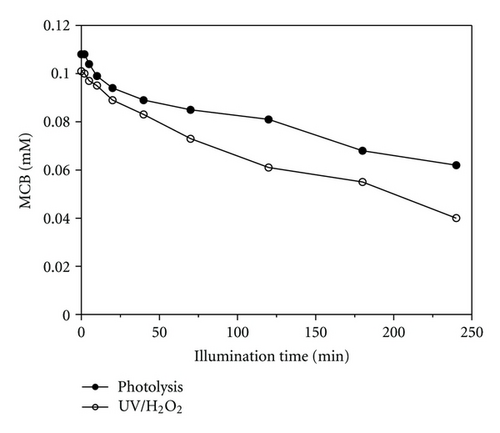
In order to evaluate the degradation ability of H2O2-assisted photolysis, an irradiation experiment was conducted under the condition of H2O2 dosage equal to 22.5 mg L−1. Corresponding to the obtained experimental result recorded in Figure 1, it was found that the concentration of MCB decreased gradually during the period of irradiation. The extent of MCB degradation in the H2O2-assisted photolysis within 240 min of irradiation was approximately 60.2% and the pseudo first-order degradation rate constant was 0.004 min−1. The typical time-dependent MCB concentration in the presence of both UV light and H2O2 was similar to that under the UV irradiation only. It was stated that H2O2 has an extremely low absorption at UV light of 365 nm [16], therefore, the generation of ·OH radicals due to the photolysis of H2O2 would be insignificant. As a result, the observable MCB decay can mainly be ascribed to the direct photolysis. Moreover, the additional MCB degradation can be explained by the oxidative ability of H2O2.
3.2. UV/TiO2/O2 Photocatalysis
3.2.1. Degradation of MCB
The dependency of the photocatalytic degradation of MCB on the initial DO concentration was studied in the range from 1.6 to 28.3 mg L−1. Typical time-dependent MCB concentration during photocatalytic degradation is illustrated in Figure 2(a). As can be seen, when TiO2 suspension was exposed to UV light, the MCB concentration decreased markedly with illumination time in comparison with the same experiment performed in the absence of TiO2. The difference between direct photolysis and UV/TiO2/O2 photocatalysis revealed that UV light and TiO2 photocatalyst together had a significant effect on the degradation of MCB. Since ·OH radicals were the key feature of UV/TiO2 process, the degradation of MCB was primarily related to the generated ·OH radicals.
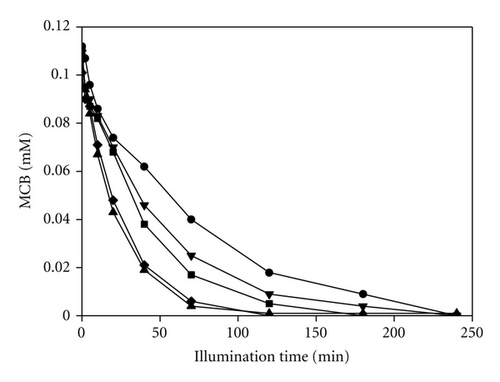
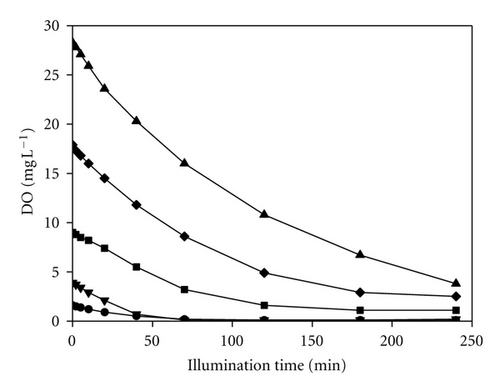
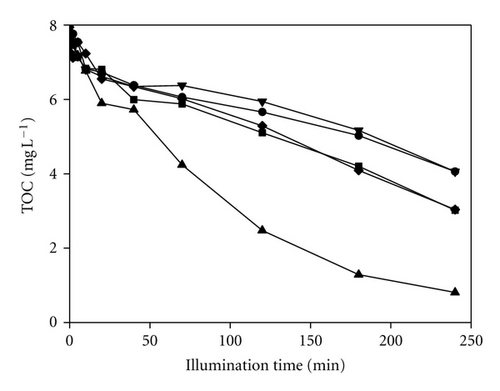
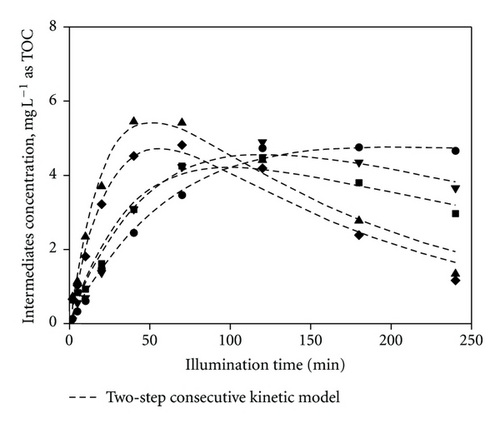
3.2.2. Mineralization of MCB
The decay of TOC during photocatalytic degradation was monitored to evaluate the mineralization of MCB. From the plot shown in Figure 2(c), the improvement of the mineralization of MCB in the presence of oxygen was observed. The mineralization efficiency increased from 42.6 to 93.1% within 240 min of irradiation as initial DO concentration varied from 1.6 to 28.3 mg L−1. Similar observations have been reported in the literature for other model compounds [22–24].
For the initial DO concentrations of 17.9 and 28.3 mg L−1, there were still measurable DO concentrations after 240 min of illumination time. Since there was sufficient oxygen in the photocatalytic system, the TOC decreased abidingly during photocatalytic degradation. Moreover, besides the electron acceptor function, oxygen can also participate in the oxidative reaction to promote the mineralization of organic substrates and intermediates [25, 26]. Consequently, the depression of TOC decay was ascribed to the lack of oxygen involved in the photocatalytic degradation afterward in the case of lower initial DO concentration.
A comparison of Figures 2(a) and 2(c) indicated that the TOC decayed with illumination time in parallel with the MCB degradation. However, it should be noted that complete disappearance of MCB occurred within 120 to 240 min of irradiation under various initial DO concentrations, whereas residual TOC was still observed. This phenomenon implied that transient organic intermediates were likely to present in the photocatalytic system.
3.2.3. Two-Step Consecutive Kinetics
As listed in Table 1, the increase in the value of k1 was proportional to the initial DO concentration. The enhancement of k1 was about 3 times higher when the initial DO concentration was 28.3 mg L−1 rather than 1.6 mg L−1. Take the calculated k1 and the determined [Inter·]c,t into (11), the value of mineralization rate constant k2 was obtained. It was evident that the mineralization rate constant depended on the initial DO concentration. The value of k2 increased with increasing initial DO concentration to a certain level and thereafter remained almost constant. The k2 increased 8 times when the initial DO concentration was increased to 17.9 mg L−1 rather than 1.6 mg L−1. Interestingly, the values of k2 were lower than those of k1, this revealed that the mineralization may be the rate-limiting step in the photocatalytic degradation of MCB. Therefore, prolonged illumination time would be reasonable for complete mineralization.
| DO concentration, mg L−1 | k1, min−1 | R2 | k2, min−1 | R2 |
|---|---|---|---|---|
| 1.6 | 0.016 | 0.9915 | 0.001 | 0.9843 |
| 3.9 | 0.020 | 0.9884 | 0.003 | 0.9787 |
| 9.0 | 0.025 | 0.9940 | 0.003 | 0.9681 |
| 17.9 | 0.038 | 0.9975 | 0.007 | 0.9591 |
| 28.3 | 0.046 | 0.9977 | 0.006 | 0.9685 |
3.3. UV/TiO2/H2O2 Photocatalysis
3.3.1. Degradation of MCB
According to its high oxidation potential and electrophilic, H2O2 is a stronger electron acceptor than oxygen [31–33]. A series of experiments were conducted with deoxygenated TiO2 suspension in order to evaluate the effect of H2O2 dosage on the photocatalytic degradation of MCB. The examined range of H2O2 dosage was varied from 5.6 to 78.0 mg L−1. From the typical temporal file exhibited in Figure 3(a), it can be seen that the degradation of MCB was sensitive to the variation of H2O2 dosage. A pseudo first-order kinetic model was provided to simulate the degradation of MCB. Table 2 summarizes the degradation rate constant k1 derived from the gradient of the plot of the natural logarithm of the normalized MCB concentration against the illumination time. When the H2O2 dosage increased from 5.6 to 22.5 mg L−1 the value of k1 increased from 0.018 to 0.026 min−1. A further increase in the H2O2 dosage from 22.5 to 78.0 mg L−1, however, led to a significant decline in the k1 from 0.026 to 0.011 min−1. The optimum H2O2 dosage for the degradation of MCB was around 22.5 mg L−1 which was similar to that observed by other researchers [20, 34–36].
| H2O2 dosage, mg L−1 | k1, min−1 | R2 | k2, min−1 | R2 |
|---|---|---|---|---|
| 5.6 | 0.018 | 0.9966 | 0.002 | 0.9836 |
| 11.2 | 0.023 | 0.9932 | 0.002 | 0.9568 |
| 22.5 | 0.026 | 0.9956 | 0.002 | 0.8682 |
| 45.0 | 0.024 | 0.9872 | 0.001 | 0.8519 |
| 78.0 | 0.011 | 0.9972 | <<0.001 | 0.9631 |
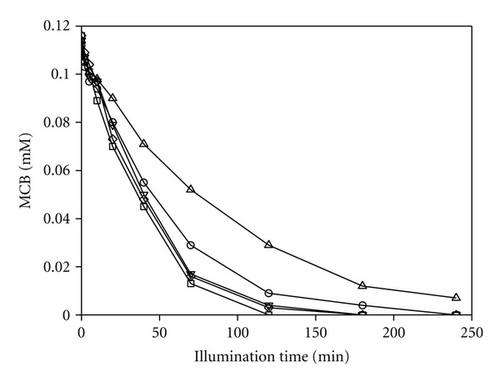
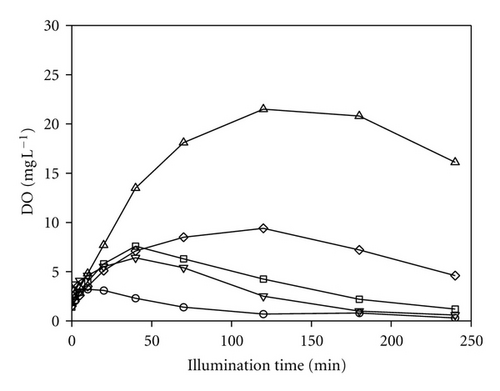
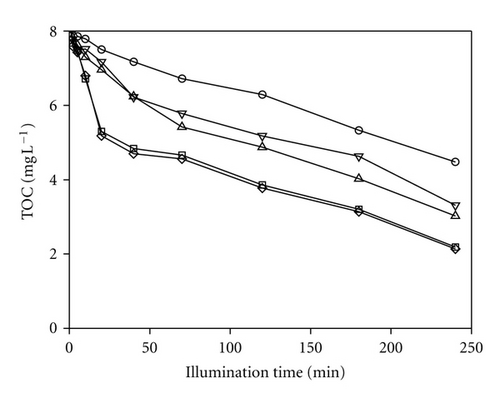
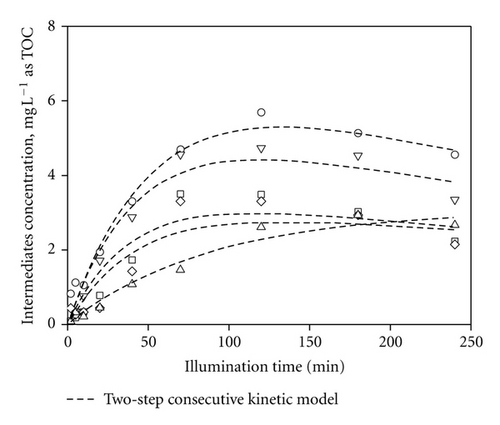
3.3.2. Mineralization of MCB
Similar to the degradation of MCB, the mineralization of MCB also took place throughout the entire irradiation. Figure 3(c) shows the concentration of TOC as a function of illumination time under various H2O2 dosages. As can be seen, the extent of TOC decay increased from 44.4 to 74.1% with H2O2 dosage increased from 5.6 to 45.0 mg L−1 after 240 min of irradiation. At higher dosage, however, the mineralization efficiency decreased to 62.5%. Reviewing the result shown in Figure 3(a), there was still observable MCB throughout the entire irradiation period in the case of H2O2 dosage equal to 78.0 mg L−1. This meant that the constraint on the mineralization efficiency may be ascribed to the competitive MCB.
Based on (8), the carbon concentration in the transient organic intermediates was determined as shown in Figure 3(d). Interestingly, the maximum value of intermediate concentration was decreased when the H2O2 dosage varied from 5.6 to 78.0 mg L−1. When H2O2 dosage was 5.6 mg L−1, the intermediates accumulated abidingly to its maximum value of 5.6 mg L−1 as TOC and then decreased. Similarly, the maximum values were 4.7, 3.5, 3.2, and 3.0 mg L−1 as TOC in the cases of H2O2 dosage equal to 11.2, 22.5, 45.0, and 78.0 mg L−1, respectively. The decline in the maximum concentration of the intermediates revealed that some fraction of mineralization was occurred in parallel with the degradation of MCB.
Applying two-step consecutive kinetic model to the determined intermediate concentration, the mineralization rate constant k2 was calculated as summarized in Table 2. It can be seen that the value of k2 was decreased with increasing H2O2 dosage. The highest k2 value was 0.002 min−1 under the experimental conditions of H2O2 dosage equal to 5.6, 11.2, and 22.5 mg L−1. Notably, when the H2O2 dosage was 78.0 mg L−1, the determined k2 value was lower than 0.001 min−1. According to the principle of the two-step consecutive kinetics, the calculation of k2 value was depend on the concentration of the intermediates and the value of k1. Consequently, the decline of the maximum intermediates concentration as H2O2 dosage was increased led to a lower k2 value.
3.4. Evaluation of Oxygen and H2O2 as Electron Acceptors
According to its characteristics as electron acceptor and oxidizing agent, the presence of oxygen in photocatalytic system was beneficial for the photocatalytic degradation of MCB. The experimental results confirmed that the photocatalytic degradation of MCB in the presence of oxygen followed a simplified two-step consecutive kinetics. For kinetic analysis, both degradation and mineralization rate constants had been demonstrated to increase with increasing DO concentration. However, this is an important consideration to bear in mind that the DO concentration in contaminated water may be limited and aeration would cause the stripping of volatile organic compound such as MCB.
It is preferential to use H2O2 where there is a limited availability of oxygen. Considering its hydrophilic property, the H2O2 would come into contact with the hydroxylated TiO2 particles in aqueous solution and trap the photoinduced e−. Furthermore, H2O2 could also serve as an oxygen source to improve the mineralization. Excess H2O2, however, could act as ·OH radical scavenger in the photocatalytic system. Moreover, the H2O2 may compete with MCB for the active sites of TiO2 particle [32, 41–44] to suppress the photocatalytic degradation of MCB. To avoid the capture of ·OH radical and competitive adsorption under high H2O2 dosage, sequential replenishment of H2O2 into UV/TiO2 system was suggested.
Referring to Figure 3, the most efficient degradation was observed where the H2O2 dosage was 22.5 mg L−1, whereas the optimal H2O2 dosage for MCB mineralization was 45.0 mg L−1. Accordingly, total dosage of H2O2 equal to 45.0 mg L−1 was chosen for the evaluation of the photocatalytic degradation of MCB under various H2O2 addition sequences. In the experiment of stepwise addition of H2O2, 22.5 mg L−1 of H2O2 was added into the TiO2 suspension, once before irradiation and again after 40 min of illumination time. As the result illustrated in Figure 4(a), 120 min of irradiation was sufficient for complete elimination of MCB in the case when a two-step addition was made. On the contrary, 180 min of illumination time was needed for the one-time addition. The enhancement of the degradation efficiency was correlated to the higher degradation rate constant when the H2O2 dosage was 22.5 mg L−1 rather than 45.0 mg L−1. Moreover, the second addition of H2O2 was attributed to sustain the suppression of the e−-h+ pair recombination.
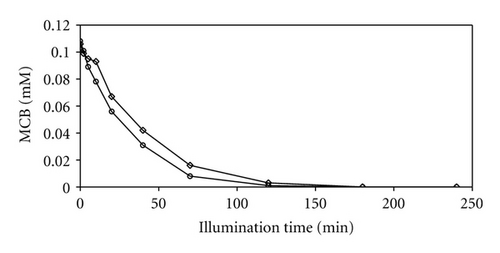
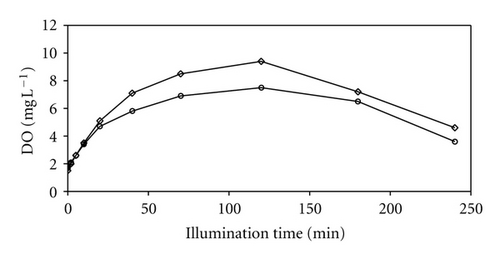
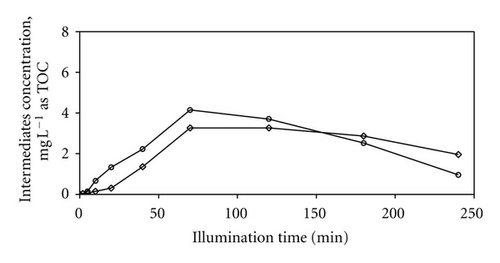
Monitoring the variation of DO concentration during photocatalytic degradation, it was observed that the oxygen accumulated continuously within 120 min of illumination time then decreased thereafter for both cases (Figure 4(b)). The concentration of the intermediates showed a similar tendency as depicted in Figure 4(c). Oxygen generated as a result of the decomposition of H2O2 whereas the accumulation of intermediates was due to the degradation of MCB. According to the effective degradation under the two-step addition of H2O2, the concentration of intermediates increased faster than that under one-time addition of H2O2. Furthermore, since oxygen would participate in the mineralization of MCB, both the concentrations of oxygen and intermediates declined afterward. A comparison of the experimental profiles shows that depletion of the intermediates concentration was shaper for the two-step addition of H2O2 than that for the one-time addition. Correspondingly, after 240 min of irradiation the mineralization efficiency of MCB in the case of two-step addition of H2O2 was 87.4% higher than the value of 74.1% in the case of one-time addition. The increment in the mineralization efficiency can be explained as due to the restraint of the capture of ·OH radicals, the additional ·OH radicals related with second dose of H2O2, and the participation of oxygen in photocatalytic degradation. Accordingly, it was evident that the sequential replenishment of H2O2 into UV/TiO2 system was advisable as a way to improve the efficiency of the photocatalytic degradation.
4. Conclusions
The direct photolysis and the oxidative potential of H2O2 were proven to have slight contribution on the degradation of MCB. Notably, UV light and TiO2 together showed a marked effect. Increasing the DO concentration was beneficial for the photocatalytic degradation of MCB. Correspondingly, the degradation and mineralization rate constants increased with the DO concentration. Owing to the mineralization of MCB occurs through the intermediates, a simplified two-step consecutive kinetics can be used to describe the photocatalytic degradation in UV/TiO2/O2 photocatalysis. For the UV/TiO2/H2O2 photocatalysis, H2O2 of lower dosage acted as electron acceptor to enhance the degradation efficiency. When the dosage was high, however, the degradation was suppressed due to the capture of ·OH radicals and the competitive adsorption of H2O2. In order to abate the disadvantages caused by using a higher H2O2 dosage, sequential replenishment of H2O2 into UV/TiO2 system was performed. Experimental results demonstrated that both degradation and mineralization efficiencies were enhanced by the restraint of the capture of ·OH radicals, the additional ·OH radicals caused from the second stage addition of H2O2, and the participation of oxygen in photocatalytic degradation.
Acknowledgment
The authors would like to thank the National Science Council, R.O.C. for financial support of this study under Contract no. NSC 90-2211-E-238-003.




